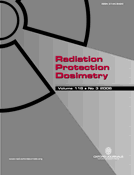-
Views
-
Cite
Cite
E. Vano, L. Gonzalez, J. M. Fernandez, C. Prieto, E. Guibelalde, Influence of patient thickness and operation modes on occupational and patient radiation doses in interventional cardiology, Radiation Protection Dosimetry, Volume 118, Issue 3, June 2006, Pages 325–330, https://doi.org/10.1093/rpd/nci369
Close - Share Icon Share
Abstract
Patient and staff dose values in an interventional cardiology laboratory for different operational modes and several patient thicknesses (from 16 to 28 cm, simulated using polymethylmethacrylate) are presented. When increasing patient thicknesses and depending on fluoroscopy and cine modes, occupational doses can increase >30 times the baseline level. Scatter dose rates at the cardiologist's position with no radiation protective tools ranged from 1 to 14 mSv h−1 for fluoroscopy, and from 10 to 47 mSv h−1 during cine acquisition. Patient entrance surface air kerma rates increased by nearly 3 and staff dose rates by up to 2.6 when fluoroscopy was moved from the low to the high mode, for a typical 20 cm thickness. The respective increase factors were 6 and 4.2 when patient thickness rose from 16 to 28 cm, and by 10 and 8.3, when comparing cine acquisition with the low fluoroscopy mode. The knowledge of typical dose rates for each X-ray system in use in catheterisation laboratories is essential in order to optimise protection of patients and staff.



